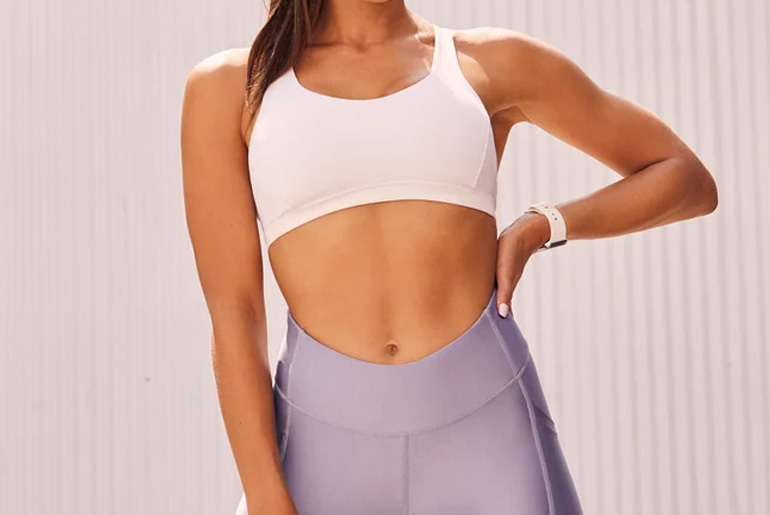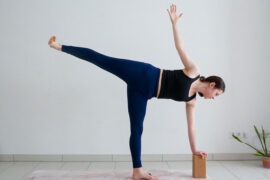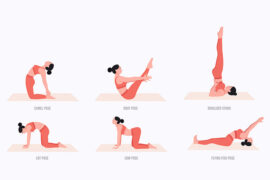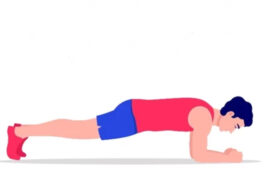Building strong abs involves a holistic approach combining targeted exercises, overall core conditioning, and a balanced lifestyle. Incorporate a variety of exercises such as crunches, leg raises, planks, and advanced movements like hanging leg raises and Russian twists to strengthen and define the abdominal muscles. Complement these with compound movements and stability work to enhance core strength. Reducing body fat through regular cardio, a balanced diet, and proper hydration is crucial for visible abs. Additionally, ensure adequate recovery with sufficient sleep and rest days to support muscle growth and overall health. Consistency and gradual progression in intensity are key to achieving and maintaining strong, defined abs.
1. Plank:
The plank is a popular and effective bodyweight exercise that targets multiple muscle groups, including the core, shoulders, back, and legs. Here’s a detailed overview of the plank exercise:
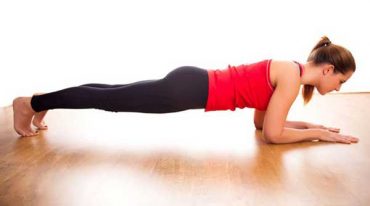
Benefits of the Plank
- Core Strength: Primarily targets the abdominal muscles, helping to build a strong core.
- Improves Posture: Strengthens the muscles around the spine, which can improve posture and reduce back pain.
- Enhances Stability: Improves balance and stability by engaging multiple muscle groups simultaneously.
- Increases Flexibility: Stretches the posterior muscles, including the shoulders, back, and legs.
- Burns Calories: As a full-body exercise, it can help increase overall calorie expenditure.
How to Perform a Basic Plank
Starting Position:
- Begin by lying face down on the floor or mat.
- Place your elbows directly beneath your shoulders and your forearms flat on the ground.
- Lift your body off the ground, keeping your elbows and toes as the only points of contact.
Body Alignment:
- Ensure your body forms a straight line from your head to your heels.
- Engage your core, tighten your glutes, and keep your hips level.
- Avoid letting your hips sag or rise too high.
Hold the Position:
- Maintain the position for as long as you can with proper form.
- Start with 20-30 seconds and gradually increase the duration as you build strength.
Breathing:
- Breathe steadily and evenly throughout the exercise.
- Avoid holding your breath.
Variations and Progressions
- Side Plank: Targets the oblique muscles. Lie on one side, lift your hips, and support your body on one forearm and the side of one foot.
- Plank with Leg Lift: While in the plank position, lift one leg off the ground, hold for a few seconds, then switch legs.
- Plank with Arm Lift: Lift one arm off the ground, hold for a few seconds, then switch arms.
- Plank with Shoulder Taps: While in the plank position, tap each shoulder with the opposite hand, alternating sides.
Common Mistakes to Avoid
- Sagging Hips: This can strain the lower back. Ensure your hips remain level.
- Rounding Shoulders: Keep your shoulders away from your ears and engage your upper back muscles.
- Holding Breath: Maintain steady breathing to prevent unnecessary tension.
Incorporating planks into your workout routine can enhance core strength and stability, improve posture, and contribute to overall fitness.
2. Mountain climbers:
Mountain climbers are a dynamic, full-body exercise that targets multiple muscle groups, including the core, shoulders, arms, and legs. They are also an effective cardio workout. Here’s a detailed overview:
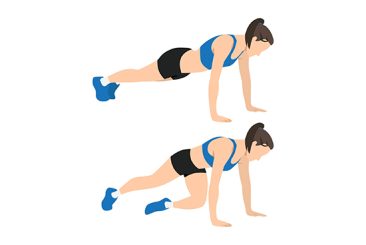
Benefits of Mountain Climbers
- Core Strength: Engages the abdominal muscles, improving core strength and stability.
- Cardiovascular Fitness: Elevates the heart rate, providing a cardiovascular workout.
- Muscle Toning: Strengthens and tones the muscles in the arms, legs, and shoulders.
- Improves Coordination: Requires coordination and balance, which enhances overall functional fitness.
- Increases Metabolism: Helps in burning calories and boosting metabolism due to its high-intensity nature.
How to Perform Mountain Climbers
Starting Position:
- Begin in a high plank position with your hands directly under your shoulders and your body in a straight line from head to heels.
- Your feet should be hip-width apart, and your core should be engaged.
Movement:
- Lift your right foot off the ground and drive your right knee towards your chest.
- Quickly switch legs, bringing your left knee towards your chest while returning your right foot to the starting position.
- Continue alternating legs in a running motion.
Form Tips:
- Keep your hips low and stable; avoid letting them bounce up and down.
- Engage your core to prevent sagging in the lower back.
- Maintain a steady, controlled pace to maximize effectiveness and reduce risk of injury.
Breathing:
- Breathe steadily and consistently throughout the exercise.
- Inhale as you bring one knee towards your chest and exhale as you switch legs.
- Variations and ProgressionsSlow Mountain Climbers: Perform the exercise at a slower pace to focus on form and control.
- Cross-Body Mountain Climbers: Bring your right knee towards your left elbow and vice versa to target the obliques.
- Elevated Mountain Climbers: Place your hands on an elevated surface, like a bench or step, to adjust the intensity.
- Mountain Climbers with a Twist: Add a twist by bringing your knee towards the opposite elbow to engage the obliques further.
Common Mistakes to Avoid
- Raising Hips: Ensure your hips stay level and do not rise too high or sag too low.
- Bouncing: Avoid bouncing or jerky movements; aim for a controlled and steady pace.
- Lack of Core Engagement: Keep your core tight to protect your lower back and maintain stability.
Mountain climbers are a versatile exercise that can be incorporated into various workout routines, including HIIT (High-Intensity Interval Training) and cardio circuits, to enhance cardiovascular fitness and overall strength.
3. Russian twists:
Russian twists are a popular core exercise that targets the oblique muscles along with the rest of the abdominal area. They are often used to improve rotational strength and stability. Here’s a detailed overview:
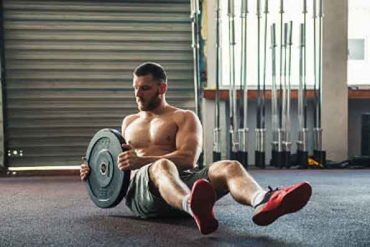
Benefits of Russian Twists
- Strengthens Core Muscles: Primarily targets the obliques, but also engages the rectus abdominis (front of the abdomen) and lower back muscles.
- Improves Rotational Strength: Enhances the ability to rotate the torso, which is beneficial for various athletic activities and functional movements.
- Increases Stability: Helps improve overall stability and balance by strengthening the core.
- Burns Calories: Engaging multiple muscle groups helps increase calorie expenditure during the workout.
How to Perform Russian Twists
Starting Position:
- Sit on the floor with your knees bent and feet flat.
- Lean back slightly so your torso is at a 45-degree angle to the ground.
- Hold your hands together in front of you, or use a weight or medicine ball for added resistance.
Movement:
- Engage your core and rotate your torso to the right, bringing your hands or weight towards the floor beside your hip.
- Return to the center and then rotate to the left, bringing your hands or weight to the opposite side.
- Continue alternating sides in a controlled motion.
Form Tips:
- Keep your back straight and avoid rounding your spine.
- Engage your core throughout the movement to maintain stability and protect your lower back.
- Ensure that the movement comes from your torso, not just your arms.
Breathing:
- Exhale as you rotate to one side and inhale as you return to the center and rotate to the other side.
Variations and Progressions
- Weighted Russian Twists: Hold a weight, medicine ball, or dumbbell for increased resistance.
- Elevated Russian Twists: Lift your feet off the ground and balance on your sit bones for an added challenge.
- V-Sit Russian Twists: Extend your legs into a V position while performing the twists for a more intense core workout.
- Bosu Ball Russian Twists: Perform the exercise while seated on a Bosu ball to increase instability and engage more stabilizing muscles.
Common Mistakes to Avoid
- Rounding the Back: Maintain a neutral spine and avoid slouching or rounding your back.
- Using Only the Arms: Ensure that the movement is driven by your torso rotation rather than just swinging your arms.
- Not Engaging the Core: Engage your core throughout the exercise to protect your lower back and maximize effectiveness.
Russian twists are an effective way to enhance core strength, stability, and rotational power. Incorporating them into your workout routine can help improve overall functional fitness and performance.
4. Bicycle crunches:
Bicycle crunches are a highly effective abdominal exercise that targets the rectus abdominis (front of the abs) and the obliques (side abs). They are a dynamic movement that combines a crunch with a twisting motion, simulating a pedaling action.
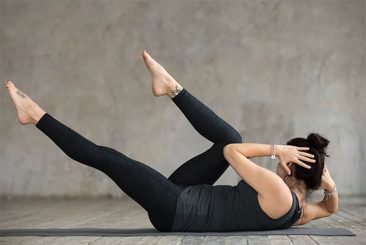
Benefits of Bicycle Crunches
- Core Strength: Engages both the upper and lower abs as well as the obliques, enhancing overall core strength.
- Improves Stability: Helps improve stability and balance by working multiple muscles simultaneously.
- Enhances Muscle Definition: Contributes to muscle definition and toning in the abdominal region.
- Increases Caloric Burn: A high-intensity exercise that can help increase calorie burn and aid in overall fat loss.
How to Perform Bicycle Crunches
Starting Position:
- Lie flat on your back on a mat or comfortable surface.
- Place your hands behind your head with your elbows pointed outward.
- Lift your legs off the ground and bend your knees to a 90-degree angle.
Movement:
- Simultaneously extend your right leg while bringing your left knee towards your chest.
- Rotate your torso to the left and bring your right elbow towards your left knee.
- Switch sides by extending your left leg and bringing your right knee towards your chest.
- Rotate your torso to the right and bring your left elbow towards your right knee.
- Continue alternating sides in a pedaling motion.
Form Tips:
- Keep your lower back pressed into the mat to avoid strain.
- Engage your core throughout the movement to maximize effectiveness and protect your lower back.
- Avoid pulling on your neck; use your abs to perform the movement.
Breathing:
- Exhale as you twist and bring your elbow towards your knee.
- Inhale as you return to the starting position and switch sides.
Variations and Progressions
- Weighted Bicycle Crunches: Hold a weight or medicine ball to increase resistance.
- Slow Bicycle Crunches: Perform the exercise at a slower pace to focus on form and muscle engagement.
- Bicycle Crunches with a Leg Lift: Extend one leg straight while performing the bicycle crunches to increase difficulty.
- Reverse Bicycle Crunches: Lie on your back with legs extended and perform a similar pedaling motion, focusing on bringing your knees towards your chest.
Common Mistakes to Avoid
- Neck Strain: Avoid pulling on your neck with your hands. Keep your head and neck in a neutral position and let your abs do the work.
- Lower Back Arching: Ensure your lower back remains pressed into the mat to prevent strain.
- Fast Movements: Perform the exercise in a controlled manner to engage the core muscles effectively.
Bicycle crunches are an excellent addition to any core workout routine, offering a combination of strength-building and cardiovascular benefits. Incorporate them into your routine to help strengthen and define your abdominal muscles.
5. Leg raises:
Leg raises are a highly effective exercise for targeting the lower abdominal muscles and improving core strength. They also engage the hip flexors and can help improve flexibility and stability.
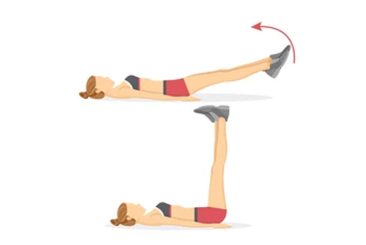
Benefits of Leg Raises
- Strengthens Lower Abs: Primarily targets the lower portion of the rectus abdominis, helping to build core strength.
- Engages Hip Flexors: Works the hip flexors, which are important for movements involving the legs and hips.
- Improves Core Stability: Enhances overall core stability and balance.
- Increases Flexibility: Helps improve flexibility in the hip flexors and lower abdominal region.
How to Perform Leg Raises
Starting Position:
- Lie flat on your back on a mat or comfortable surface.
- Place your arms at your sides with palms facing down, or under your hips for additional support.
- Keep your legs extended and together.
Movement:
- Slowly lift your legs towards the ceiling, keeping them straight.
- Raise them until they are perpendicular to the ground or as high as you can comfortably go.
- Lower your legs back down slowly to just above the ground, keeping your core engaged to avoid arching your lower back.
- Repeat for the desired number of repetitions.
Form Tips:
- Engage your core throughout the movement to prevent lower back strain.
- Keep your legs straight and avoid using momentum to lift them.
- Maintain a controlled pace to maximize muscle engagement.
Breathing:
- Exhale as you lift your legs.
- Inhale as you lower your legs back down.
Variations and Progressions
- Bent-Knee Leg Raises: Perform the exercise with your knees bent to reduce difficulty and focus on engaging the core.
- Hanging Leg Raises: Hang from a pull-up bar and lift your legs to increase the challenge and engage the core more intensely.
- Weighted Leg Raises: Hold a weight between your feet or wear ankle weights to add resistance.
- Flutter Kicks: Perform small, rapid kicks with your legs while keeping them extended to further engage the lower abs.
Common Mistakes to Avoid
- Arching the Lower Back: Ensure your lower back remains flat on the mat to prevent strain. Engage your core to maintain proper form.
- Using Momentum: Lift and lower your legs in a controlled manner; avoid swinging or jerking.
- Bending the Knees: Keep your legs straight throughout the exercise to fully engage the lower abs.
Leg raises are a valuable addition to any core workout routine, especially for targeting the lower abs and enhancing overall core strength and stability. Incorporate them into your routine for effective abdominal conditioning.
Disclaimer:
The information contained in this article is for educational and informational purposes only and is not intended as a health advice. We would ask you to consult a qualified professional or medical expert to gain additional knowledge before you choose to consume any product or perform any exercise.

